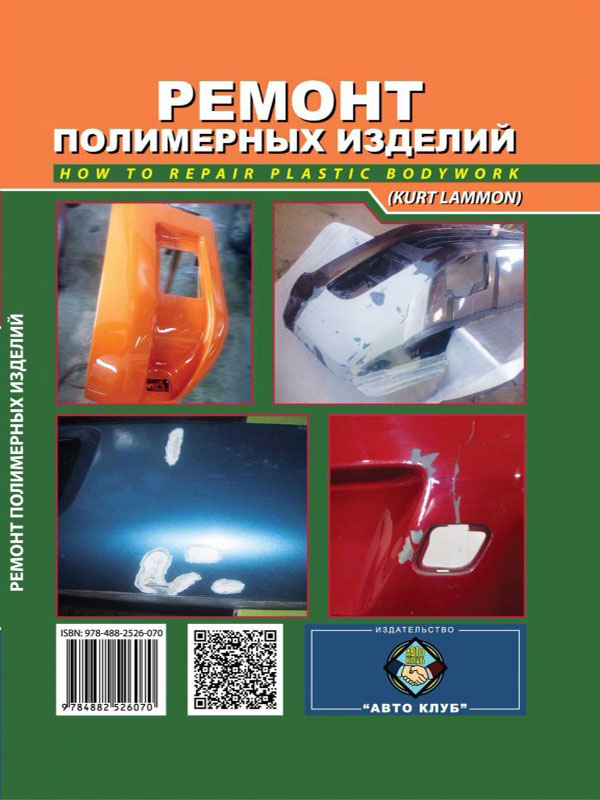
|
Specifically dedicated to polymer and biopolymer systems, Polymer Adhesion, Friction, and Lubrication guides readers to the scratch, wear, and lubrication properties of polymers and the engineering applications, from biomedical research to automotive engineering. Author Hongbo Zeng details different experimental and theoretical methods used to probe static and dynamic properties of polymer materials and biomacromolecular systems. Topics include the use of atomic force microscopy (AFM) to analyze nanotribology, polymer thin films and brushes, nanoparticles, rubber and tire technology, synovial joint lubrication, adhesion in paper products, bioMEMS, and electrorheological fluids. Получить ссылку |
 Repair of polymer products car moto, book in the photographs in eBook
Repair of polymer products car moto, book in the photographs in eBook
Автор: Автоклуб
Год издания:
Content
Introduction
Repair or not repair - that's the issue!
- Injection molding: working principle
Identification of types of polymeric materials
- Thermoplastics against thermosets
- Thermoplastics: polypropylene, polyvinyl chloride (PVC), polycarbonate,
- polyethylene, nylon (polyamide), acrylonitrile butadiene styrene (ABS plastic)
- Reaktoplasty: epoxy resin, urethane, polyester
- Polymer materials for cars
- Vehicles for recreation and entertainment
Possible repair methods for each type of plastic
- Reaktoplasty
- Thermoplastics
Repair procedures
- Basic procedure for repairing & nbsp; processing
- Two-component adhesives
- Cyanoacrylate adhesive
- Hot-melt adhesive
- Methacrylate adhesive
- Introduction to polymer welding
Finishing processing plastic
- Durable neolefin plastic types
- Plastic neolefin plastic types
- Painted thermoplastic polyolefin and polypropylene
- Unpainted thermoplastic polyolefin and & nbsp; polypropylene
- Polyethylene
Applications
- Tools their purpose
- How to achieve optimal adhesion
 What are Polymers? (Что такое полимеры?)
What are Polymers? (Что такое полимеры?)
Автор: А. Н. Безруков
Год издания:
Рассмотрены вопросы строения, получения, применения полимеров и исследования их свойств. Отвечает требованиям дисциплин «Специализированный профессионально-ориентированный перевод» (английский язык) и «Английский язык (технический перевод)». Содержит технические основы науки о полимерах на английском языке, теорию технического перевода и комплекс заданий для аудиторной работы по практике перевода и изучению терминологии.
 Friction at the Atomic Level. Atomistic Approaches in Tribology
Friction at the Atomic Level. Atomistic Approaches in Tribology
Автор: Motohisa Hirano
Год издания:
Written by one of the most distinguished scientists and a pioneer in this field, this monograph represents a stand-alone, concise guide to friction at the atomic level. It brings together hitherto widely-scattered information in one single source, and is the first to explain the nature of friction in terms of atomic mechanisms. In addition to his detailed description on modeling and simulation, the author stresses stresses experimental approaches like AFM techniques for verification. In this respect the book will benefit the whole nanotribology community, from graduate students who want to get the basics right up to researchers specializing in mechanical engineering, materials science, physics and chemistry.
 Self-Healing Polymers. From Principles to Applications
Self-Healing Polymers. From Principles to Applications
Автор: Wolfgang Binder H.
Год издания:
Self-healing is a well-known phenomenon in nature: a broken bone merges after some time and if skin is damaged, the wound will stop bleeding and heals again. This concept can be mimicked in order to create polymeric materials with the ability to regenerate after they have suffered degradation or wear. Already realized applications are used in aerospace engineering, and current research in this fascinating field shows how different self-healing mechanisms proven successful by nature can be adapted to produce even more versatile materials. The book combines the knowledge of an international panel of experts in the field and provides the reader with chemical and physical concepts for self-healing polymers, including aspects of biomimetic processes of healing in nature. It shows how to design self-healing polymers and explains the dynamics in these systems. Different self-healing concepts such as encapsulated systems and supramolecular systems are detailed. Chapters on analysis and friction detection in self-healing polymers and on applications round off the book.
 Encyclopedia of Polymer Blends, Volume 1. Fundamentals
Encyclopedia of Polymer Blends, Volume 1. Fundamentals
Автор: Avraam Isayev I.
Год издания:
A complete and timely overview of the topic, this volume of the encyclopedia imparts knowledge of fundamental principles of polymer blends. Each article is uniformly structured for easy navigation, containing the latest research & development and its basic principles and applications.
Чтобы скачать книгу, отключите блокировку рекламы. Спасибо!





